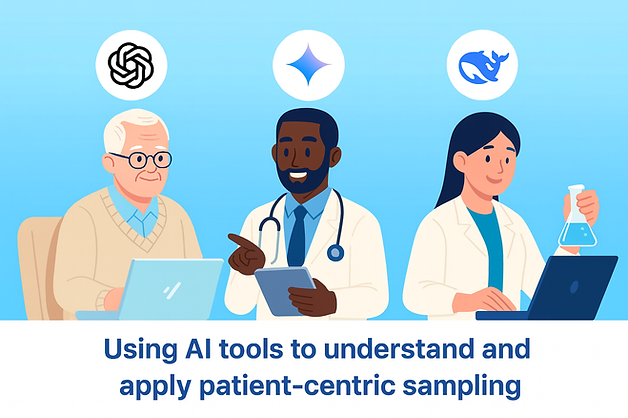Building AI Queries for Patient Centric Sampling Applications

The following is a guidance framework for how to structure queries in your preferred AI tool, to efficiently search for specific use cases of sampling devices, especially when you want to pair them with target analytes or assays (like CMV, HbA1c, CRP, etc.).
General Strategy
When searching for sampling device use cases, your query should include:
1. Sample type, e.g., liquid versus dry sample, capillary blood versus plasma / serum.
2. Device name, e.g., “Capitainer B”, “Neoteryx Mitra”, “Tasso+”, “YourBio TAP Micro”, etc.
-
See PCSIG website for a listing of more devices
3. Analyte or biomarker, e.g., “cytomegalovirus viral load”, “hemoglobin A1c”, “C reactive protein”, “cytokines”.
4. Study setting or context (optional), e.g., “As a clinician treating rare disease patients”, “remote monitoring”, “field use”, “low-resource settings”, “pediatric”, etc.
5. Keywords indicating application, e.g., “use case”, “clinical validation”, “case study”, “performance”, “comparison”, “accuracy”, “patient preference”.
6. Check references - Ensure that your AI tool is set-up to show the references it is using. Don’t forget to check them yourself!
Pro-Tips
1. Use synonyms or alternative terms
-
Sampling device → “microsampling”, “capillary collection”, “home blood collection”, “remote phlebotomy”, “dried blood”
-
Assay → “biomarker test”, “laboratory assay”, “immunoassay”, “(insert assay methodology)”
-
Analyte → "analyte", or be specific: "cytokines", "immunosuppressants", "drug levels", “lipids”, “chemistry”, “liver panel”, “kidney panel”, “proteins”, etc.
2. Combine query components thoughtfully
Try this format:
"Use of [device] for [analyte] in [setting] – validation or study data"
Example:
"Tasso Mini for HIV antibody detection in decentralized trials"
3. Consider using follow-on queries to better define the output
Peer reviewed publications only
Studies that have been used in clinical practice
Example Queries You Can Use in Your Preferred AI Tool
Focused on Specific Analyte
-
"Use of Tasso devices for cytomegalovirus viral load monitoring in transplant patients"
-
"Validation of capillary blood collection for hemoglobin A1c with Tasso+ or Neoteryx"
Focused on Assay or Performance
-
"Comparison of dried blood spot vs venous sampling for cytokine assays"
-
"Assay validation for CRP using microsampling devices"
Technology-Agnostic or Comparative
-
"Remote blood collection devices for longitudinal monitoring of immunologic biomarkers"
-
"Clinical trials using upper-arm blood collection for infectious disease serology"
Contextual / Situational
-
"Provide a checklist of operational considerations for introducing microsampling into a multi-country trial"
-
"Case study of blood microsampling in decentralized clinical trials"
-
"Feasibility of home collection of blood for pharmacokinetic studies"
Templates You Can Copy and Paste
"Use of [sampling device name] for [analyte or biomarker] in [context or study type]; include validation or clinical performance data"
Substitute:
-
[sampling device name] → Capitainer B, Neoteryx Mitra, Tasso+, YourBio TAP Micro, etc.
-
[analyte] → cytomegalovirus, interleukin-6, hemoglobin A1c, antibody levels, C reactive protein
-
[context] → transplant monitoring, decentralized trials, pediatric patients
Creating Comparison Tables
"Create a table comparing the cost, usability, and sample stability of devices X. Y and Z"
Generating Case Studies
"Give examples of published clinical trials that successfully used microsampling for PK analysis"
Making Checklists
"Provide a checklist of operational considerations for introducing microsampling into a multi-country trial"
Important Reminder: Always Fact-Check
AI assistants are powerful tools for learning and brainstorming, but sometimes it may produce information that sounds correct but is not accurate (this is called hallucination).
-
Ask your AI tool for sources: You can say, "Please list references or sources for your answer"
-
If an answer seems unclear or too confident, ask a follow-up question like "Can you double-check this?" or "What evidence supports that statement?"
Disclaimer
PCSIG is not responsible for the accuracy, completeness, or appropriateness of outputs from your AI query.
It is the user’s responsibility to fact-check all information, verify with authoritative sources, and ensure suitability for their specific clinical, scientific, regulatory, or personal use.
